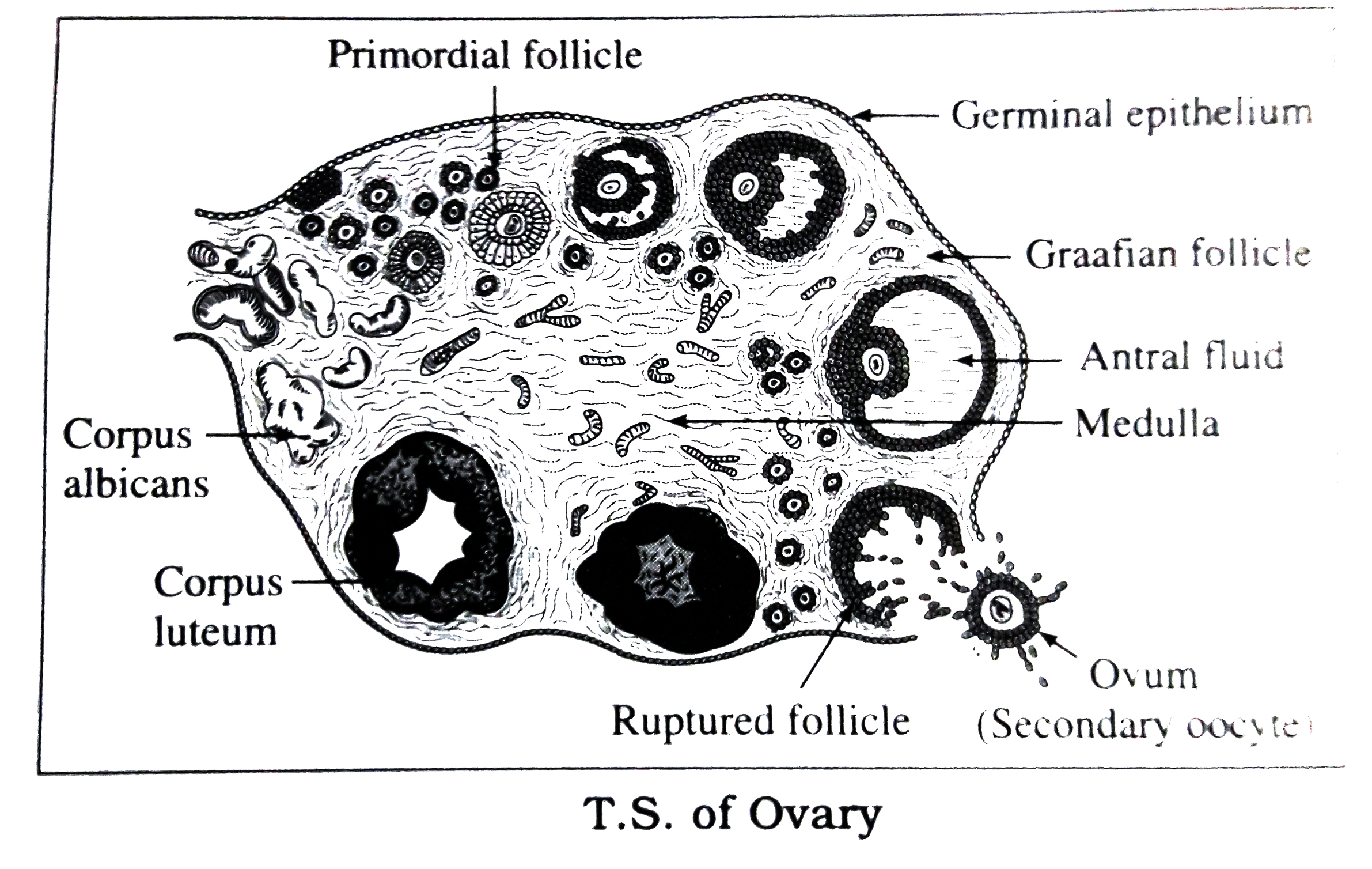Draw a neat labelled diagram of T.S. of ovary and describe various phases of menstural cycle.
Video Solution
Text Solution
T.S. of Ovary :

2. Menstrual cycle.
(1) Menstrual cycle starts with menarche and ends with meno pause. It lasts for about 28 days and is repeated throught this period with exception of duration of pregnancy.
(2) There are series of changes in uterus and ovaries during the menstural cycle and these changes are regulated by gonadotropin hormones from pituitary and hormones of ovary.
(3) Hormones, FSH, LH. estrogen and progesterone are respon-sible for these cyclic changes in mature females.
(4) Menstrual cycle is divided into four phases , viz., menstrual phase, proliferative phase (in uterus) or follicular phase (in ovary), ovulatory phase, secretory phase (in uterus) or luteal phase (in ovary).
(1) Menstural phase : Menstrual phase 1st to 4th day in the absence of fertilization. During this phase bleeding occurs as the endometrium of uterus is sloughed off. The thickness of endometrium becomes 1 mm. After about 4th day of bleeding, once again the FSH secretion from the pituitary is resumed and the new follicle starts developing.
(2) Follicular phase (in ovary) or Proliferative phase (in uterus) :
(i) Ovarian chanes : When the ovary is in follicular phase, the uterus enters in proliferative phase. This takes place from 5th to 13th day of the cycle. During this phase the new primordial follicle in the ovary develops due to the action of FSH from pituitary. Primordial follicle gradually changes into Graafian follicle, producing the hormone estrogen. Only one follicle develops in one cycle.
(ii) Uterine changes : The uterus also undergoes proliferation. The endometrial glands of uterus are stimulated and repair process of the uterus takes place under teh infulence of estrogen. The thicnkess of endometrium grows to about 3 mm to 5 mm.
(3) Ovulatory phase : Ovulation takes place, on the 14 th day of the cycle. The mature Graffian follicle ruptures due to LH secreted by the pituitary. The ovum is released in abdominal cavity. This ovum is picked up by the fimbrine of infundibulum of fallopian tube. It passes through the fallopian tube. On its way if it happens to meet sperm, it is fertilized. If unfertilized , the ovum degenerates.
(4) Luteal phase (Ovary) or Secretory phase (Uterus) :
Luteal phase in the ovary corresponds with the secretory phase in the uterus . It takes place between 15th to 28th day of the cycle.
(i) Ovarian changes : In the ovary the courpus luteum is formed from the empty Graffian follicle. The corpus luteum produces progestrone. If ovum is fertilized the corpus lutuem is retained. Hormones LH and LTH from pituitary help in the maintance of corpus luteum. If the ovum is ot fertilized , the corpus luteum degenerates and forms corpus albicans.
(ii) Uterine changes : Under the influence of progesterone, ther is increase in the thicnkess of endometrium. Endometrial glands grow and become secretory. The hormone progesterone is responsible for the maintenance of pregnancy. If fertilized ovum reaches the uterus. If is implanted and placenta is formed. This leads to pregnancy Till placenta becomes functional the corpus luteum keeps on producing progesterone. If progesterone source is cut off, the endometrium sloughs off and the mensturation begins, as in case of no conception.
|
Topper's Solved these Questions
- LONG ANSWER QUESTIONSBOOK - NAVNEET PUBLICATION - MAHARASHTRA BOARDCHAPTER - LONG ANSWER QUESTIONSEXERCISE - Additional Important Questions for Self-practice
1 Videos
- LONG ANSWER QUESTIONSBOOK - NAVNEET PUBLICATION - MAHARASHTRA BOARDCHAPTER - LONG ANSWER QUESTIONSEXERCISE - Control and Coodination
13 Videos
- GIVE REASONS BOOK - NAVNEET PUBLICATION - MAHARASHTRA BOARDCHAPTER - GIVE REASONS EXERCISE - Organisms and Environment - II
2 Videos
- MATCH THE COLUMNS/MATCH THE PAIRS/COMPLETE THE TABLEBOOK - NAVNEET PUBLICATION - MAHARASHTRA BOARDCHAPTER - MATCH THE COLUMNS/MATCH THE PAIRS/COMPLETE THE TABLEEXERCISE - Chapter 19 : Organisms and Environment - II
3 Videos
Similar Questions
Draw a neat labelled diagram of T.S. of mature anther.
View SolutionDraw a neat labelled diagram of nucleus.
View SolutionDraw a well labelled diagram of T.S. anther.
View SolutionDraw a neat and well labelled diagram showing T.S. Of ovary and describe the menstrual cycle in human female.
View SolutionDraw a well labelled diagram of L.S. of human ovary
View SolutionDraw a neat labelled diagram of a biogas plant.
View SolutionDraw a neat labelled diagram of a transformer.
View SolutionDraw a neat labelled diagram of a transformer.
View SolutionDraw a well labelled diagram of T.S. ovary of human female.
View SolutionDraw a neat labelled diagram of Hope's apparatus.
View Solution
